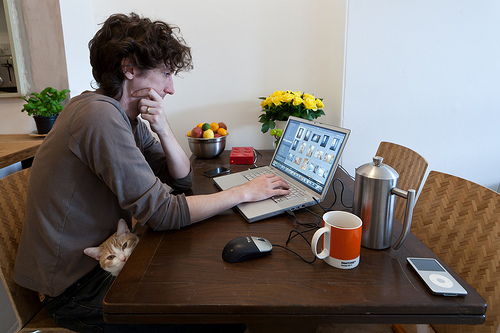Say you were given the choice between:
(a) Rolling out of bed at 8:00 AM, starting the tea pot—notice I didn’t say putting on slacks or restrictive footwear—then logging into your work email to start your day from the couch at 8:30 AM, with the morning news humming softly in the background.
(b) Waking up at 6:30 AM, throwing on yoga clothes and getting in a quick workout, taking a shower, putting on makeup and work clothes, packing your lunch and then rushing to the car to drive twenty minutes to work so you’re able to get into the office by 8:30 AM on the dot.
Seems like a given that you’d go with “a,” or at least anything other than “b,” right?
As someone who has worked from home for the last three years, I’m quick to sing the praises of telecommuting, from the flexibility to take my dogs on a walk in the middle of the workday to the conduciveness to juice cleanses. I’m not the only one hyping this nontraditional work style. A survey conducted in the three largest urban areas of Sweden found that satisfaction with work commute contributes to general levels of happiness. It almost goes without saying that no work commute means even greater overall happiness but, just in case, it is being said—Stanford economics professor Nick Bloom conducted a study that compared the productivity of call-center employees at a company based in Shanghai and found that working from home “boosts employee happiness and productivity.”
So no more downtown Skyline? Not quite. Bloom’s report does not reach the conclusion that requiring employees to work from home is a sure-fire way to improve company success and employee happiness. Findings suggest that flexibility is key, meaning that a company trying to capitalize on this trend towards at-home work would do well to give employees the option of telecommuting and allow individuals to choose the locale that works best for them. The numbers seem to show that U.S. companies are listening—the U.S. Census bureau found that the percentage of all employees who worked at least one day at home increased from 7% in 2007 to 9.5% in 2010.
If you’re fortunate enough to be in that growing 9.5%, then you know from experience that a day devoid of workplace drama, fluorescent lighting and restrictive business casual wear is not without its cons. Forbes Contributor Sunday Steinkirchner, who manages her own rare books company out of her Manhattan home office, points out the key issue with a lack of physical separation between work and life: “When spending long stretches [working] at home, it’s our first inclination to spend every waking hour working. It can be hard to take a break and impose structured hours on ourselves.” Working from home may mean less stress as interruptions are less likely to come in the form of a Bill Lumbergh-like coworker and more likely to be in the form of Spot the family dog, but work/life balance still needs to be a conscious priority to ensure overall happiness.
So how do you ensure work/life balance when you don’t have a clear work/life distinction? Here are a few pro tips from the trenches:
- Take breaks! When you’re first starting to accept that your employer trusts you to work without direct supervision, you’ll feel inclined to work 8-6:30, as in longer than the 9-5 that your in-office coworkers are putting in. Try taking a lunch break as well as taking ten minute breaks throughout the day. This ensures that time spent in front of your laptop is committed to being productive rather than to zoning out from exhaustion.
- If you don’t trust your self-awareness of how many hours you’re putting in, listen to your family and friends. If your partner’s asking you to put down the laptop during dinner more than one time during the week, take note. It can be easy to mindlessly check your inbox if your workspace is near your hangout space. If it’s becoming an issue, move your laptop during dinnertime or set a time during the day when you don’t allow yourself to check your inbox.
- Distinguish between your spaces. While some Fridays I just need to work from the couch to get through the day, I also have a desk in my spare room and I work from this makeshift office for 95% of the workweek. That’s not to say that you necessarily need a spare room to serve as an office. Any spot where you can focus will work.
Now that you’re armed with tips that will help you make the most of remote work, get to working—and living!
More in Career: Gender Inequality is Real–So Why Do We Dismiss Feminism?
Career Health Check: Is Your Job Right For You?
Photo: Daveybot via photopin cc





